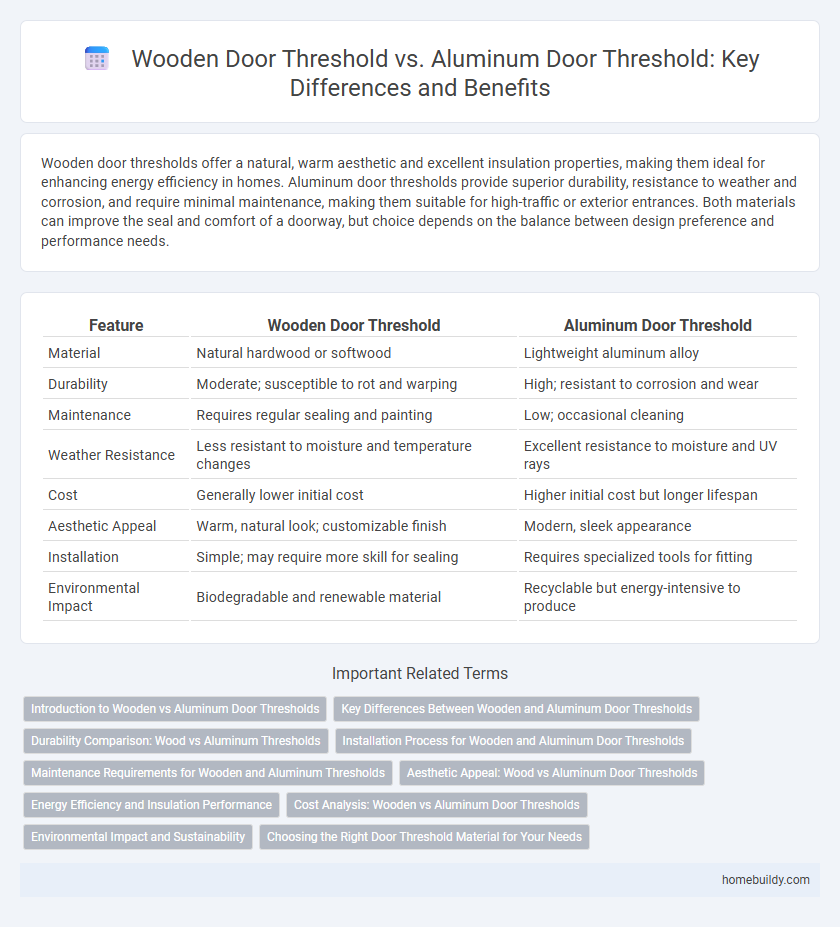Wooden door thresholds offer a natural, warm aesthetic and excellent insulation properties, making them ideal for enhancing energy efficiency in homes. Aluminum door thresholds provide superior durability, resistance to weather and corrosion, and require minimal maintenance, making them suitable for high-traffic or exterior entrances. Both materials can improve the seal and comfort of a doorway, but choice depends on the balance between design preference and performance needs.
Table of Comparison
| Feature | Wooden Door Threshold | Aluminum Door Threshold |
|---|---|---|
| Material | Natural hardwood or softwood | Lightweight aluminum alloy |
| Durability | Moderate; susceptible to rot and warping | High; resistant to corrosion and wear |
| Maintenance | Requires regular sealing and painting | Low; occasional cleaning |
| Weather Resistance | Less resistant to moisture and temperature changes | Excellent resistance to moisture and UV rays |
| Cost | Generally lower initial cost | Higher initial cost but longer lifespan |
| Aesthetic Appeal | Warm, natural look; customizable finish | Modern, sleek appearance |
| Installation | Simple; may require more skill for sealing | Requires specialized tools for fitting |
| Environmental Impact | Biodegradable and renewable material | Recyclable but energy-intensive to produce |
Introduction to Wooden vs Aluminum Door Thresholds
Wooden door thresholds offer natural insulation and aesthetic warmth, enhancing energy efficiency and complementing traditional interiors. Aluminum door thresholds provide superior durability, corrosion resistance, and low maintenance, ideal for high-traffic or exterior applications. Selecting between wooden and aluminum thresholds depends on factors such as climate, design preference, and intended usage.
Key Differences Between Wooden and Aluminum Door Thresholds
Wooden door thresholds offer natural insulation and aesthetic appeal with their warm, classic look, while aluminum thresholds excel in durability and resistance to corrosion and weathering. Aluminum thresholds tend to be lighter, require less maintenance, and provide better moisture resistance compared to wooden ones, which may warp or rot over time. The choice between wooden and aluminum thresholds ultimately depends on factors like climate, maintenance preferences, and desired visual style.
Durability Comparison: Wood vs Aluminum Thresholds
Wooden door thresholds offer natural insulation and aesthetic warmth but tend to wear down faster due to moisture, rot, and insect damage, impacting long-term durability. Aluminum door thresholds excel in durability with resistance to corrosion, weathering, and heavy foot traffic, making them ideal for high-use areas or harsh climates. Maintenance requirements also differ, with aluminum needing less frequent upkeep compared to the periodic sealing and refinishing wooden thresholds demand.
Installation Process for Wooden and Aluminum Door Thresholds
Wooden door thresholds typically require precise cutting, sanding, and sealing to ensure a snug fit and protection from moisture, often necessitating additional finishing like staining or varnishing post-installation. Aluminum door thresholds involve a straightforward installation process utilizing pre-drilled holes and screws, with minimal modifications needed, making them quicker and easier to install. Both types demand accurate measurements, but the lightweight nature and durability of aluminum thresholds often result in reduced installation time compared to wood.
Maintenance Requirements for Wooden and Aluminum Thresholds
Wooden door thresholds require regular sealing and occasional sanding to prevent moisture damage and warping, demanding more frequent upkeep compared to aluminum. Aluminum door thresholds are highly resistant to rust and corrosion, necessitating only periodic cleaning to maintain their durability and appearance. Choosing aluminum reduces long-term maintenance efforts, making it ideal for high-traffic or exposed entryways.
Aesthetic Appeal: Wood vs Aluminum Door Thresholds
Wooden door thresholds offer a warm, natural aesthetic that complements traditional and rustic interior designs, providing a rich texture and grain that enhances visual appeal. Aluminum door thresholds present a sleek, modern look with clean lines and a metallic finish, ideal for contemporary and minimalist spaces seeking durability and low maintenance. Choosing between wood and aluminum thresholds depends on desired style, with wood emphasizing classic elegance and aluminum favoring industrial chic.
Energy Efficiency and Insulation Performance
Wooden door thresholds offer superior natural insulation due to wood's low thermal conductivity, helping to minimize heat loss and reduce energy consumption in buildings. Aluminum door thresholds, while durable and resistant to weather, conduct heat more readily, potentially leading to higher energy costs unless paired with thermal breaks or insulation inserts. Choosing wooden thresholds enhances overall energy efficiency by providing better thermal resistance, crucial in maintaining indoor comfort and lowering heating and cooling expenses.
Cost Analysis: Wooden vs Aluminum Door Thresholds
Wooden door thresholds generally cost less upfront, averaging between $20 to $50, but require frequent maintenance and potential replacement due to susceptibility to moisture and wear. Aluminum door thresholds have a higher initial cost, typically ranging from $40 to $100, but offer superior durability, corrosion resistance, and lower long-term maintenance expenses. Overall, aluminum thresholds provide better value over time despite the higher initial investment, especially in high-traffic or exterior applications.
Environmental Impact and Sustainability
Wooden door thresholds offer biodegradable properties and can be sourced from sustainably managed forests, reducing carbon footprints through natural carbon sequestration. Aluminum door thresholds, while durable and recyclable, require significant energy-intensive mining and refining processes, increasing environmental impact compared to wood. Choosing wooden thresholds promotes renewable materials and lower embodied energy, whereas aluminum thresholds benefit from long-term recyclability but with higher initial environmental costs.
Choosing the Right Door Threshold Material for Your Needs
Wooden door thresholds offer natural insulation and aesthetic warmth, making them ideal for traditional homes where maintaining cozy indoor temperatures is essential. Aluminum door thresholds provide superior durability and resistance to weathering, suitable for high-traffic areas or locations exposed to moisture and temperature fluctuations. Selecting the right material depends on balancing factors such as maintenance requirements, environmental exposure, and desired longevity for optimal performance.
Wooden door threshold vs Aluminum door threshold Infographic

 homebuildy.com
homebuildy.com